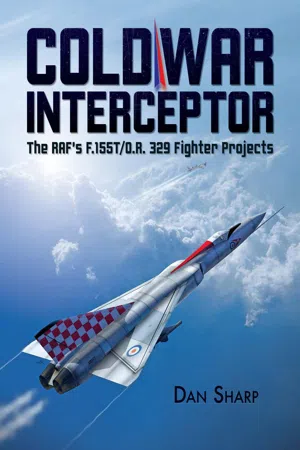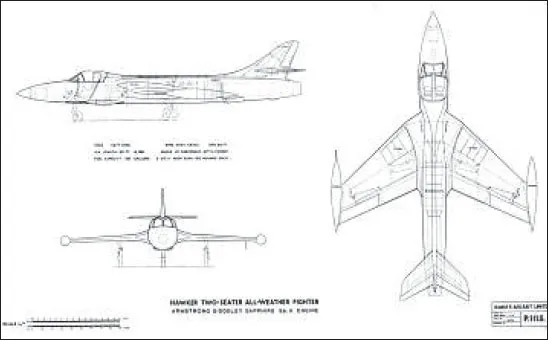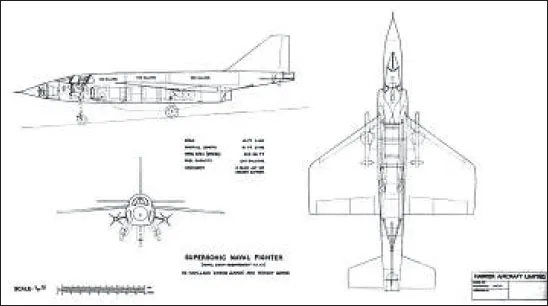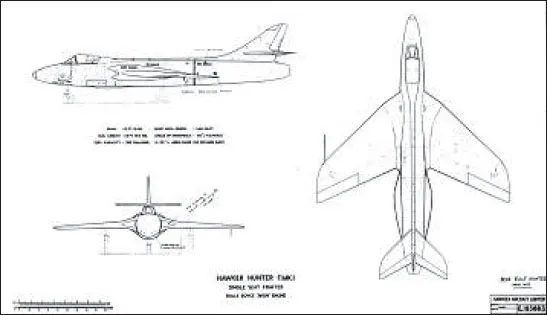![]()
FINAL DECISION
The future of fighters
With the detailed interceptor brochures now in hand, the Ministry of Supply, the Air Staff and the technical specialists began their assessment to determine which company would be declared the winner and offered a contract to build its design. The contest did not end quite as expected, however.
Alongside a highly detailed design brochure, each company tendering for F.155T had to supply a letter outlining the costs associated with its aircraft. Particularly illuminating were the figures given for designing and supplying it in quantities of 12, 18 and 24 aircraft.
The most expensive by a considerable margin was de Havilland’s DH.117 – a hefty £937,000 per aircraft (£22.5m in today’s money – still peanuts compared to the £125m cost of a single Eurofighter Typhoon) if 24 were ordered. Next most expensive was Saunders-Roe’s P.187 at £718,715 each for 24, followed by Vickers-Armstrongs’ Type 559 at £565,000 apiece for two dozen.
Just behind this was Fairey’s Large design at £557,000 each and £343,000 each for its Small design. English Electric declined to offer three prices on a sliding scale, asking instead for a lump sum up front of £7,366,682 for 24 examples, valuing each aircraft at £306,945 – less than a third of the cost of a DH.117.
Right at the bottom end of the scale were the Hawker and Armstrong Whitworth designs. Hawker wanted just £285,000 per aircraft in a batch of 24, while AWA’s AW.169 was positively bargain basement at just £270,000 (£6.5m in today’s money) each for an order of 24.
With all of the brochures in hand by October 8 – Fairey’s two having apparently been received late – and having quickly skimmed through them, project officer Ian Otto Hockmeyer wrote a memo headed ‘Notes on Firms’ Philosophy’. For Fairey he wrote: “Choice of delta planform: gives excellent manoeuvrability at high altitude, best landing and takeoff characteristics and lightest structure, suitable for engines in fuselage. Can draw on experience of ER.103. Choice of two engines and steel and titanium construction provides scope for development up to Mach 3.
“English Electric: The only certainty of meeting service date will result from a ‘short step’ development of the existing F.23/49, AI23 and IR weapon combination. This excludes a large and complex radar collision system and leads to the adoption of the twostage concept based on the claims made for an all round IR weapon: it entails height differential and threedimensional interception with beam riding information from a single ground station.
“Hawker: The objective is to submit the smallest possible aircraft to meet the requirement of the specification. Blue Vesta or small Vickers radar weapon is offered since the Red Hebe is completely out of harmony with an aircraft of this type. Swept wing chosen for favourable transonic characteristics, load relieving ability and structural suitability for the single engine arrangement. Advantages of detachable rocket motor.
“De Havilland: To meet service date of January 1962 some pruning of equipment and weapon system is thought to be necessary. Doubt about availability of Red Hebe, therefore, initially designing for Blue Vesta and relying on its all round capabilities. Expect to be able to develop the equipment systems; particularly towards increased automaticity, with time. Importance of twin engines. Straight wing chosen to obtain: high lift at low speed (hence smaller area and lower weight), reduces stability and handling difficulties, less tendency for pitching troubles near the stall (at high subsonic speeds), better directional stability above Mach 1.5. DH.110 experience.
“Armstrong Whitworth: Service date precludes unconventional design. No alternative configuration offers significant advantage (except similar rear-tailed aircraft with negative longitudinal stability). Scope for development in steel. Unswept wing allows engines to be in underslung nacelles and facilitates change of type (as well as accessibility). Advantages also in landing attitude and in weapon positioning.
“Vickers-Armstrongs (Supermarine): Belief that structure and equipment adjacent to jet nozzles may suffer damage from high frequency vibrations (noise) – hence nozzles must be extreme aft. To avoid tail heaviness and to avoid long portion of ‘hot’ fuselage led to canard layout. Further merit that foreplane contributes to lift, reduces wing size and weight. Weapon change in two hours. Consider that group organisation of interceptors will be extremely limited are due to aircraft’s relatively short endurance. Hence Intermittent Proportional Navigation or Intermittent beam riding do not appear attractive. Suggest use of EW and GCI in close association with a small number of interceptor bases. GCI would employ a number of ground mounted AI sets each locking on to its individual target. Interceptor would pick up beam at 26,000ft. Saving of aircraft nav equipment and reduce organisational delay time.
“Saunders-Roe: Belief that Issue 2 of the specification is regarded as a concession and that Air Staff really want Issue 1 to be met: this the firm claims to have done in full and produced an aircraft with development capacity to Mach 3 and truly all weather (the special sliding nose ensures excellent landing vision). The aircraft follows the design of current designs (F.138D and P.177) and this limits the development required and new problems to be solved.
“Avro Canada: The firm were asked to comment on Specification F.155T and have submitted the CF-105 brochure and a statement of its capability relative to F.155T. This they have done. A further stage of study, to examine what might be done to approach the F.155T requirement by increasing engine thrust, will be undertaken if the Ministry of Supply (MoS) requests.”
Three days later, a meeting was held to discuss the tenders. The chairman was MoS Director General of Technical Development (Air) George Gardner and in attendance were 10 Air Ministry representatives, four men from the RAE, two from the RRE and another 10 from the Ministry of Supply, plus Hockmeyer as secretary.
Gardner began by stating that the Deputy Chief of the Air Staff, Sir Thomas Pike, had asked whether the F.155T should be made a pursuit course interceptor only due to “the difficulty of reconciling performance, equipment and all-upweight”. Gardner said this needed to be considered and that the meeting was to “decide how further work should be steered to try and arrive at a sane and wise design when the choice of weapon system was made”.
Air Ministry Assistant Chief of the Air Staff (Operational Requirements) Air Vice-Marshall Harold Vivian Satterly then “explained that the Air Staff had become alarmed, as the requirement crystallised, at the weight of the fighter”. He said Pike thought the RAF might get a bigger fighter force if Red Hebe was ditched and only Blue Vesta (Blue Jay Mk.4) missiles were specified.
At this point the MoS’s Director General of Guided Weapons, John Edward Serby, interjected to say he could not accept the suggestion that Red Hebe “could not be developed and produced in seven years and stated that it was a matter for Air Ministry to arrange appropriate priority”.
The RAE had estimated that removing Red Hebe from the spec would lighten those aircraft designed for both types of missiles by 10,000lb and it was noted at this point that both the Hawker and small Fairey submissions had not met the F.155T performance requirements. It was also noted that Saunders-Roe’s design, able to carry both missiles, had an allup-weight of nearly 100,000lb and it was agreed that the firm should be given the opportunity to put forward the smaller design it had mentioned in its brochure.
Further discussions then ensued about the relative effectiveness of Blue Vesta versus Red Hebe against targets at various altitudes and speeds. This debate went round in circles until it was finally agreed that “for the time being, precedence should be given to those designs which catered for the carriage of both Blue Vesta and Red Hebe”.
There was then a long discussion about the various airborne intercept (AI) radars available and whether the F.155T should be ground-controlled for part of its mission. It was decided that a second meeting should be held in a month’s time when it might be possible to eliminate “those designs which were clearly unacceptable, and subsequently to concentrate on those which offer the full collision course facility”. The date was set for November 28 at 3.30pm.
No second chance for Saro
On October 13, 1955, Hockmeyer wrote: “Saunders-Roe assumed that the Air Staff still really wanted the original concept and regarded Issue 2 as of the nature of a concession. They made this assumption despite the information they received when representatives of Air Staff visited them on June 14: my notes of this visit indicate that Air Staff said that the change from Issue 1 to Issue 2 was a deliberate change of policy and not a concession. Initially Saunders-Roe appeared to take advantage of what, on April 5, was a concession, in their design work, but some three months ago decided to try and meet the full original requirements and this is what has been submitted in their design brochure.
“At a meeting held by Gardner on October 11, Satterly stated that they were not interested in this larger Saunders-Roe offer, the meeting felt, however, that the firm should be invited to complete and submit their design for a smaller aircraft. In their brochure they state that they can do this very quickly. It is for consideration as to whether such action would be equitable in relation to the other firms in the competition.
“One offer at least falls short of the requirements, namely that of Hawkers. My view is that such firms should not be given the chance of submitting another design. The Hawker design in particular has been offered in the teeth of the specification ‘as their view of the next logical step in fighter development’.
“On the other hand it should be recalled that I was instructed to impress upon the firms informally that if they thought the present specification (i.e. Issue 1) too ambitious to be met within a reasonable time they should not hesitate to bring this up at the April meeting. It could be said that Issue 2 was in fact a recognition of an opinion that the specification was too ambitious.”
Hockmeyer asked whether Saunders-Roe should be allowed to submit a design for a smaller aircraft. His superior, George Leitch, stated that he had no objection to this on October 14, 1955.
However, three days later the Air Ministry’s Director of Contracts (Air), A W Isherwood, wrote: “We spoke about this i.e. the invitation to tender for the F.155T. The proposal to invite Saunders-Roe only to submit an alternative tender would be quite contrary to the normal principles of competitive tendering.
“In my view, it is necessary either to extend the time and give all the firms a chance to think again or to consider only the tenders already submitted. I gather that you propose to adopt the second course.”
Isherwood’s decision, to prevent Saunders-Roe from submitting a smaller design, had the effect of freezing the other firms’ designs too. Only the brochure designs submitted would be considered – although further explanation of these designs’ features was allowable.
On October 28, Air Ministry Deputy Director of Operational Requirements 1, Group Captain Neil Wheeler, wrote a memo stating: “I am at a loss to understand how we can ever legislate for a firm that is determined to be kind to us. The requirement is quite clearly stated in the issue of OR.329 that is current and I do not believe we should take any further action to explain the background to the deletion of the necessity to carry a mixed weapon load.
“Moreover, if Saunders-Roe get an order for the P.177, which I believe must go through, we cannot possibly tie up the whole of our future fighter development with Saunders-Roe. Rather, therefore, than worry unduly over persuading Saunders-Roe not to tell us what we think we want, can we not concentrate on the other aircraft.”
Shortly after its P.1103 brochure had been submitted, Hawker produced the P.1115 – one of many inte im interceptor designs of the pe iod. It had wingtip tanks for extended patrol, two seats and radar, but two Aden cannon rather than guided weapons. BAE Systems
Another advanced design from Hawker, dating from November 1955, was this supersonic fighter for the Na y– to Naval Staff Requirement NA.47. It serves to indicate the direction of Hawker’s thinking on supersonic guided weapon-equipped fighter design – with options of a ventral fuel tank and rocket motor in the extreme end of the fuselage. BAE Systems
Eliminations
Between November 5 and November 9, the Air Ministry carried out its own quick assessment of Avro Canada’s CF-105 brochure against the requirements of OR.329. The following day, Satterly wrote a summary: “The CF-105 as planned for introduction into the Royal Canadian Air Force will be equipped with a US fire control system and US guided missiles stowed internally. In this form the aircraft could be made available to the RAF in about 1960.
“The aircraft does not meet the requirements of OR.329. Using the Falcon missile (astern attack) the aircraft would be capable of destroying its target at a range of 17½ miles from the coast. Provision has also been made for the carriage of the Sparrow2 which was designed to be capable of front hemisphere collision course attacks.
“Using this weapon the aircraft could theoretically deal with the Mach 1.3 threat at a distance of 64 miles from coast. Unfortunately, I understand that many problems have been encountered in the development of this weapon and it is now unlikely this or any other suitable collision course weapon will be available in time.”
He said it might be possible to fit the CF-105 with a British radar and missiles but this would delay its introduction until about 1962: “Blue Vesta is the only suitable weapon which could be stowed internally. The aircraft so equipped would not be capable of meeting the requirements of OR.329, the performance being similar to that of the RCAF Falcon missile. Red Hebe could only be carried externally and I believe that the decrease in aircraft performance caused by the carriage of this weapon would be considerable.”
As the F.155T competition continued, Hawker worked on ways of improving the performance of its Hunter fighter, the...





